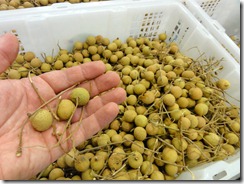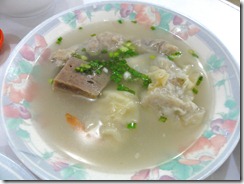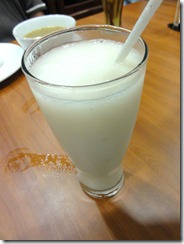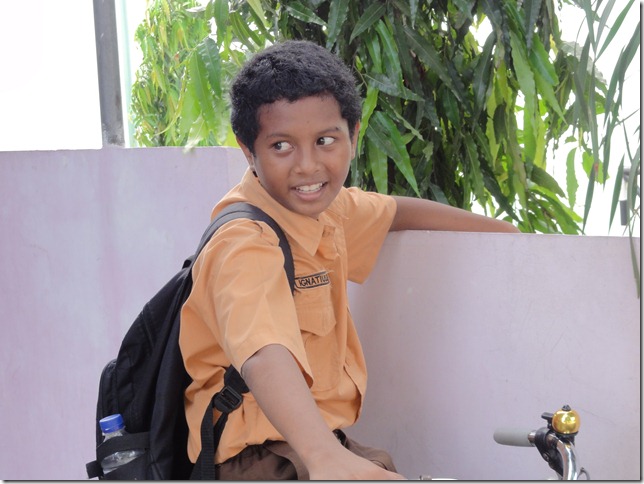
Guest blog by Kian –

After an intense day of shooting with Cak Nur in Surabaya, we decided to take the next half-day off. We negotiated our way across relentless traffic in front of our hotel. Loud, hot, fume-ridden highway. Soon we found a small alley to escape the noise and the heat. Midway in we heard the now familiar perkutut song, Klau koo koo koo koong… The sound brought a certain calmness and tenderness to me. We looked up and not far away were two poles, each with a perkutut in its cage. The hobby is pervasive.

Further down the narrow alley there was a small open space, roofed with tiled floor. The sign said that the pavilion was used for village meetings and a make-shift infant clinic (Posyandu). Next to that was a tiny “Taman Bacaan”, a kid’s library.

We left the alley and we noticed a little boy was following us on his bicycle. He stopped when we stopped, usually when Jim was taking pictures. Jim smiled and waved at him and held up his camera to ask if he could take his picture. The boy, dressed in a brown school uniform, smiled and nodded. I read the name tag sewn above his shirt pocket –Ignatius R.R. “Ignatius, are you Kristen?” I ask. “Katolik,” he answers. In Indonesia, Kristen usually means Protestant.
His extracurricular class was cancelled so he was out early. The R.R. in his name is the initial of his church. This is the first Christian we met in Java. We continued our walk and he followed a few yards behind. We passed a warung, a street-side stall, and I turned to ask him if he would like us to buy him food. He nodded and we all went in to sit on the bench.

Ignatius ordered Mie Ayam, chicken noodle soup, and a sprite. “How is it?” I ask. “Enak dagingnya,” he replied, scooping the last of the tiny bits of chicken in his bowl. The meat is delicious, he said. That brought back my childhood. I remembered not eating much meat at all growing up. We had little resources. Yet now that I could afford a lot more meat, it doesn’t bring more satisfaction.
Ignatius is the oldest of 3 kids, the youngest is a girl. His father works in a plastic factory, mom’s a kindergarten teacher. No school allowance, the money is for tuition and food. Ignatius cooks a lunch of rice with fried eggs every day for his younger siblings. Sometimes he adds fried tofu. His parents came from one of the islands east of Bali, Flores, famous for its ikat weaving. There is only one other Christian family in his neighborhood.

Ignatius is not shy like Javanese boys. He a nswers straight without giggling. I say you must be good at school. “Rangking delapan,” he answers. He is ranked 8th in a class of 40. He is also very good looking, composed and polite. In his face I read a determination to survive. I respected him. I wish I had a son like Ignatius.
Rice Farmers and Pedicab Drivers

Outside of the cities in Java, you can see the ever present rice fields at different stages of their life cycles. First, rice grains are sown tightly in a field nursery. The slender new plants form bright green patches in the field, surrounded by water that reflects the sky. These are replanted in rows in a flooded field. As they mature, they change into different shades of green before rice stalks appear. These too start as green and then turn golden yellow. To mature properly, the flooded field must be drained or the rice grain won’t fill. Rain is not wanted during this time.
Here too the climate is behaving more and more unpredictably. It should be the dry season now, lasting 6 months from April to September. But the sky is cloudy and rain comes every other day. You can see why they don’t want rain. Whole fields collapse, sometimes before they’re ready for harvesting. Even if they’re mature enough, you have to harvest them in three days or the new grains will start to germinate.

We stopped whenever we saw rice harvesting to shoot some footage and to talk. We the workers were farm laborers, people without land. They get a small share of the rice they harvest. When there is no farm work, men go to cities like Solo to drive pedicabs. You can see so many of them in Solo. They offer their service by saying “Becak?” every time we pass. We shake our head and smile. They smile back generously.

We didn’t see enough people using their service. Most are idle or asleep in their pedicabs. We rode in a becak once in Solo. The compartment felt tight. Had we been eating too much Indonesian food? Then he started pedaling from the back; we in front facing traffic. It felt a little unnerving but our driver was so happy he was giddy laughing, almost all the way. Life must be harsh but he knew how to be happy.
Volcanoes
When we were in Jogjakarta, Jim was so curious about volcanoes. Jogjakarta is near an active volcano, Mount Merapi, but we couldn’t see it. I remember seeing Mt. Merapi from Jogjakarta when I was there fifteen years ago. Maybe it’s the pollution.

Growing up in Indonesia, I have seen enough mountains and volcanoes. I climbed a few in my twenties. I say to Jim, they are overrated triangular things with smokes coming out of the apex. Let’s move on! But he refuses to be convinced.
So we rent a car to go to Borobudur, the giant Buddhist temple from the 9th century, situated on a hill closer to Mt. Merapi. The temple is magnificent. I’ve been there three times, each time I am overwhelmed. Jim snaps away at the reliefs. A lot of depictions of birds, especially Kinara and Kinari, a pair of half human half bird. May be we can use it in the perkutut film.


But it is so crowded! Everyone wants to have photo with Jim. As soon as we stop, the requests come. You have to stop. It’s damned crowded. We can see more than one mountain from the temple. There is Mt. Merapi, Mt. Merbabu and the Menoreh Mountian range where people still hunt the green jungle fowl (see next posting).
So you think Jim is happy now? The next day, our driver, Pak Amin, took us to Merapi Pass, the highest point drivable at Mt. Merapi. The site has a restaurant and a theater where you can see the last eruption of Mt. Merapi. The stone tablet was signed by former President Megawati Sukarnoputri. Everywhere you look, the hills are carved by vegetable and strawberry fields. Every eruption brings incredibly fertile volcanic ash.
Green Jungle Fowl

Jungle fowls are ancestors of domesticated chickens. Indonesia has two species, red jungle fowl and green jungle fowl. Green jungle fowls are indigenous to Java. The rooster is beautiful, with a green and blue metallic face.
Do you remember Pak Aris Munandar, the bekisar farmer, husband of Sri, who was leaving Aris and their three small kids, to work in Egypt? Aris told me that green jungle fowls could still be found in the Menorel Mountain Range in Central Java. They are hunted for food and for the caged bird market. I have a weakness for roosters.
Green jungle fowls are monogamous. Their habitat is the edge of forest near an open field. The Menoreh Mountain range provides this ideal habitat – the valley to forage and the mountain to hide.
We didn’t have a chance to see the birds in their habitat. We only saw them in Taman Mini in Jakarta and in Pak Aris’s cages. It’s very difficult to keep a jungle fowl captured from the wild. Humans stress them out. They soon refuse to eat and die. So the Javanese hunt for the eggs and have them hatched by domesticated hens. The chicks are less finicky although you still have to keep them away from too many humans. You have to feed them organic insects, those caught in the grass, not from the rice field. They cannot be overweight. You cannot transport them in cages or they’ll jump uncontrollably and injure themselves to death. So, Aris binds his with sarong before wrapping it inside his rooster carrier when he sold one to a customer in Semarang, 5 hours away with motorbike.

The Javanese also cross green jungle fowl rooster with a certain kind of domesticated hen to produce bekisar – a rooster that crows only in two syllables. They find the crowing beautiful. This I don’t get. I’ve listened to them crowing in a competition for half day. Eventually I recognize the good crowing, “Aw Eh”. The first syllable has to be loud and low, the second high and effortless.

Some bekisar enthusiasts understand the issue of species extinctions and have started breeding the green jungle fowls. But as of now, the price of wild caught green jungle fowl is still lower than the one bred in captivity. I have come to accept that a lot more species will go extinct in my lifetime. But still it hurts to watch. What shall we do?
Stew Roosters with Painkiller
Everywhere in the island of Java, Madura and Bali, native domesticated chickens roam free, crossing the street whenever they want. “Why did the chicken cross the road?” “Which road?” says the chicken.

My late father used to raise these chickens in our backyard. Maybe because of that I am always fond of watching chicken roaming free. From our car, we can see them scavenging for insects on the shoulder of highways. Most of the time, you see a mother hen with a few cute chicks tugging along. Single parenting is prevalent in chickens too.
In Bali, the chicken population seems to be significantly higher. Maybe because Bali doesn’t have as much heavy industry like Java?
Anyway, in Gunung Kawi, Bali, we are sort of followed by 2 young juvenile roosters. They are tiny but you can see that their tails start to curve, a sign of rooster. Everywhere we turn, we see them. They get along so well, too. Hmmn, gay boys?
The Balinese love cockfights. It could be part of the religious ritual. Our driver, Awan, is a very good informant. After the main ceremony in the temple ends, the cockfight starts. The owner of the winning cock gets to cook and eat the loser. “Have you even eaten one of those roosters,?” Awan asks me. I shake my head. “Enak sekali,!” Awan says. It’s very delicious.
I tell him rooster meat is chewy. Awan explains. First you rub spiced oil in the rooster spurs, i.e. the weapon located at the feet. One strike will weaken and kill the loser immediately because of the oil. And it makes the meat so tasty. What about the chewiness? You cook it with sliced young pineapple and one tablet of Bodrex, Indonesian-made painkiller.




 Tjong brings de Sève to his native Indonesia to filmManDove, which takes us inside the world of perkutut, a type of singing dove bred for potentially lucrative competition throughout Indonesia and Southeast Asia. Held in Solo, the National Perkutut Championship takes place in a large field filled with hundreds of ornate bird cages hoisted high on metal poles; judges affix flags to the poles, assigning points to the perkutut’s song. The film offers an intimate look at several competitors and the daily care of their birds, including the waning practice of ‘tuning’ birds through the use of string in constricting the pitch of their song. Amongst these bird fanciers, we find a broad cross section of Indonesian society, ranging from common citizens to a former high-ranking general under the Suharto regime.
Tjong brings de Sève to his native Indonesia to filmManDove, which takes us inside the world of perkutut, a type of singing dove bred for potentially lucrative competition throughout Indonesia and Southeast Asia. Held in Solo, the National Perkutut Championship takes place in a large field filled with hundreds of ornate bird cages hoisted high on metal poles; judges affix flags to the poles, assigning points to the perkutut’s song. The film offers an intimate look at several competitors and the daily care of their birds, including the waning practice of ‘tuning’ birds through the use of string in constricting the pitch of their song. Amongst these bird fanciers, we find a broad cross section of Indonesian society, ranging from common citizens to a former high-ranking general under the Suharto regime. The filmmakers addressed questions about translation and subtitling, part of a broader discussion about modulating one’s focus between knowledge and wonder, as well as the filmmaker’s role in facilitating access into another culture. According to Jim, “part of the idea, the design of this film, is to keep you in the dark a little bit”, discussing their desire to give viewers some latitude for interpretation within certain scenes. Kian further elaborated: “We thought maybe the contact between them and Jim could be a start, to discuss colonialism… but of course, we don’t want to say that… instead of distilling, and presenting Vitamin C, we present the orange, the fruit, and you decide what part of it you want.”
The filmmakers addressed questions about translation and subtitling, part of a broader discussion about modulating one’s focus between knowledge and wonder, as well as the filmmaker’s role in facilitating access into another culture. According to Jim, “part of the idea, the design of this film, is to keep you in the dark a little bit”, discussing their desire to give viewers some latitude for interpretation within certain scenes. Kian further elaborated: “We thought maybe the contact between them and Jim could be a start, to discuss colonialism… but of course, we don’t want to say that… instead of distilling, and presenting Vitamin C, we present the orange, the fruit, and you decide what part of it you want.”





























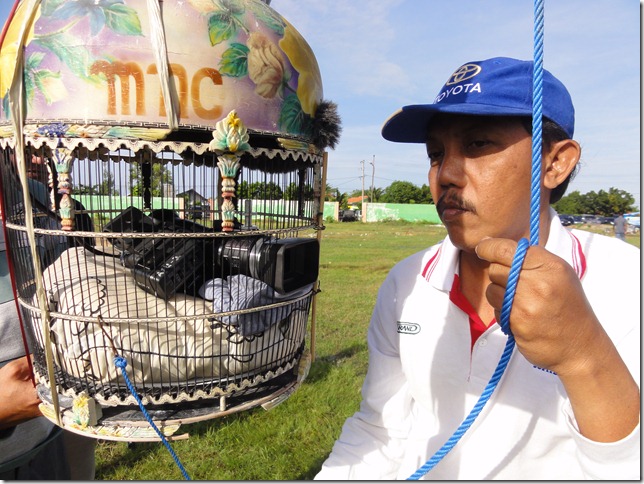














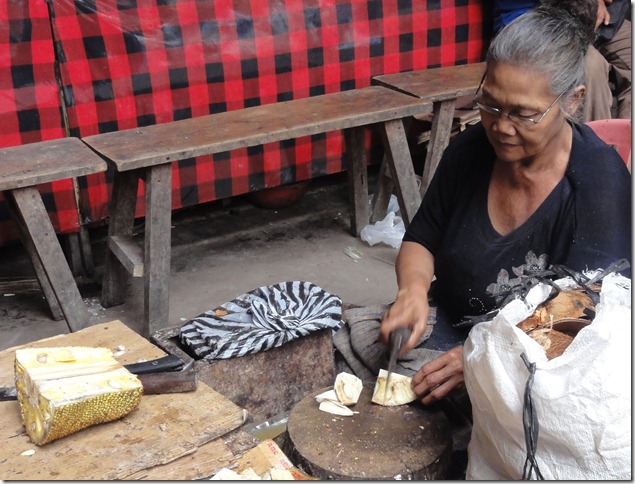



 (Bananas, pineapple, watermelon, salak (snakefruit), papaya)
(Bananas, pineapple, watermelon, salak (snakefruit), papaya)











